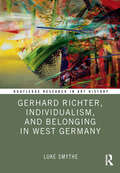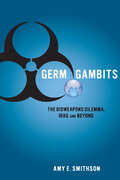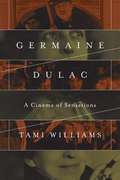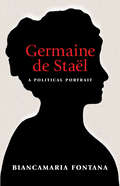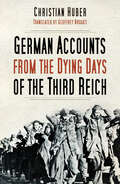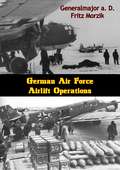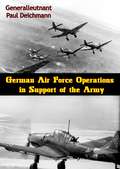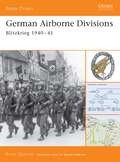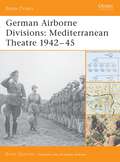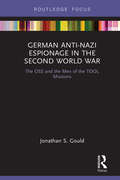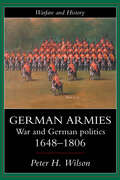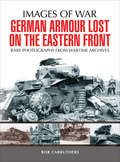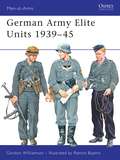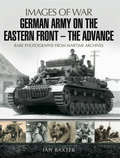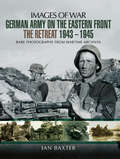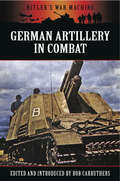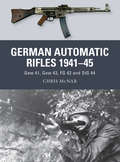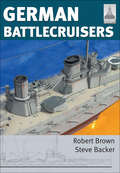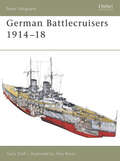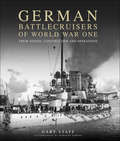- Table View
- List View
Gerda Walther’s Phenomenology of Sociality, Psychology, and Religion (Women in the History of Philosophy and Sciences #2)
by Antonio CalcagnoThis book explores the philosophical writings of Gerda Walther (1897–1977). It features essays thatrecover large parts of Walther’s oeuvre in order to show her contribution to phenomenologyand philosophy. In addition, the volume contains an English translation of part of hermajor work on mysticism.The essays consider the interdisciplinary implications of Gerda Walther’s ideas. A student of Edmund Husserl, Edith Stein, and Alexander Pfänder, she wrotefoundational studies on the ego, community, mysticism and religion, and consciousness.Her discussions of empathy, identification, the ego and ego-consciousness,alterity, God, mysticism, sensation, intentionality, sociality, politics, and woman arerelevant not only to phenomenology and philosophy but also to scholars of religion, women’s and gender studies, sociology, political science, and psychology.Gerda Walther was one of the important figures of the early phenomenologicalmovement. However, as a woman, she could not habilitate at a Germanuniversity and was, therefore, denied a position. Her complete works have yet to bepublished. This ground-breaking volume not only helps readers discover a vital voice but it also demonstrates the significant contributions of women to early phenomenological thinking.
Gerda's Lawman
by Lena Nelson Dooley"He was coming down the stairs in the hotel lobby while we were waiting for Gustaf and Olina to arrive. I glanced up," Gerda said as a blush moved up her cheeks, "and when our eyes met, it was as if everything within me connected with everything in him. I don't know how to explain it. For a moment, I felt as if we were the only two people in the room." Anna looked as if she were holding back a chuckle. "That's interesting." Gerda got up and walked to the window nearest the sewing machine. She held back the curtain and gazed at nothing in particular. "Don't you see? All these years I've waited for God to bring me someone to love, and the only person I've felt anything special for is a man who isn't a Christian. I've been praying for God to take the temptation from me. I just can't get too close to him, because..." After a moment, Anna asked, "Because what?" Gerda turned away and crossed her arms. "I'm afraid I could fall in love with him very easily. I can't risk that."
Gerhard Richter, Individualism, and Belonging in West Germany (Routledge Research in Art History)
by Luke SmytheThis book reevaluates the art of Gerhard Richter (b. 1932) in relation to his efforts to achieve belonging in the face of West Germany’s increasing individualism between the 1960s and the 1990s. Richter fled East Germany in 1961 to escape the constraints of socialist collectivism. His varied and extensive output in the West attests to his greater freedom under capitalism, but also to his struggles with belonging in a highly individualised society, a problem he was far from alone in facing. The dynamic of increasing individualism has been closely examined by sociologists, but has yet to be employed as a framework for understanding broader trends in recent German art history. Rather than critique this development from a socialist perspective or experiment with new communal structures like a number of his colleagues, Richter sought and found security in traditional modes of bourgeois collectivity, like the family, religion, painting and the democratic capitalist state. The book will be of interest to scholars working in art history as well as German history, culture and politics.
Germ Gambits
by Amy E. SmithsonArms control and nonproliferation treaties are among the fingers in the dike preventing the unthinkable nuclear, biological, and chemical catastrophe. For decades the ability to ascertain whether states are hiding germ weapons programs has been nonexistent because the 1975 bioweapons ban has no inspection measures. Yet, in 1995 a small United Nations inspection corps pulled off a spectacular verification feat in the face of concerted resistance from Iraq's Saddam Hussein and popular skepticism that it was even possible to conduct effective biological inspections. Working from sketchy intelligence—and hampered by the Iraqis' extensive concealment and deception measures—the inspectors busted open Iraq's cover stories and wrested a confession of biowarfare agent production from Baghdad. This rigorously researched book tells that compelling story through the firsthand accounts of the inspectors who, with a combination of intrepidness, ingenuity, and a couple of lucky breaks, took the lid off Iraq's bioweapons program and pulled off an improbable victory for peace and international security. The book concludes by drawing lessons from this experience that should be applied to help arrest future bioweapons programs, by placing the Iraq bioweapons saga in the context of other manmade biological risks, and by making recommendations to reduce those risks. While written as an engaging, analytical historical narrative that explains what the biological inspectors knew, when and how they knew it, and how they outmaneuvered the Iraqis, this book's real contributions are the inspectors' blueprint to "get it right" with regard to the verification challenges associated with the bioweapons ban, and the author's roadmap to address the overall biological threats facing the world today.
Germaine Dulac: A Cinema of Sensations
by Tami WilliamsBest known for directing the Impressionist classic The Smiling Madame Beudet and the first Surrealist film The Seashell and the Clergyman, Germaine Dulac, feminist and pioneer of 1920s French avant-garde cinema, made close to thirty fiction films as well as numerous documentaries and newsreels. Through her filmmaking, writing, and cine-club activism, Dulac's passionate defense of the cinema as a lyrical art and social practice had a major influence on twentieth century film history and theory. In Germaine Dulac: A Cinema of Sensations, Tami Williams makes unprecedented use of the filmmaker's personal papers, production files, and archival film prints to produce the first full-length historical study and critical biography of Dulac. Williams's analysis explores the artistic and sociopolitical currents that shaped Dulac's approach to cinema while interrogating the ground breaking techniques and strategies she used to critique conservative notions of gender and sexuality. Moving beyond the director's work of the 1920s, Williams examines Dulac's largely ignored 1930s documentaries and newsreels establishing clear links with the more experimental impressionist and abstract works of her early period. This vivid portrait will be of interest to general readers, as well as to scholars of cinema and visual culture, performance, French history, women's studies, queer cinema, in addition to studies of narrative avant-garde, experimental, and documentary film history and theory.
Germaine de Stael: A Political Portrait
by Biancamaria FontanaGermaine de Staël (1766-1817) is perhaps best known today as a novelist, literary critic, and outspoken and independent thinker. Yet she was also a prominent figure in politics during the French Revolution. Biancamaria Fontana sheds new light on this often overlooked aspect of Staël's life and work, bringing vividly to life her unique experience as a political actor in a world where women had no place.The banker's daughter who became one of Europe's best-connected intellectuals, Staël was an exceptionally talented woman who achieved a degree of public influence to which not even her wealth and privilege would normally have entitled her. During the Revolution, when the lives of so many around her were destroyed, she succeeded in carving out a unique path for herself and making her views heard, first by the powerful men around her, later by the European public at large. Fontana provides the first in-depth look at her substantial output of writings on the theory and practice of the exercise of power, setting in sharp relief the dimension of Staël's life that she cared most about--politics. She was fascinated by the nature of public opinion, and believed that viable political regimes were founded on public trust and popular consensus. Fontana shows how Staël's ideas were shaped by the remarkable times in which she lived, and argues that it is only through a consideration of her political insights that we can fully understand Staël's legacy and its enduring relevance for us today.
German Accounts from the Dying Days of the Third Reich: German Accounts from World War II
by Geoffrey Brooks Christian HuberUnlike other historical depictions of the fall of the Third Reich, German Accounts from the Dying Days of the Third Reich presents the authentic voices of those German soldiers who fought on the front line. Throughout we are witness to the kind of bravery, ingenuity and, ultimately, fear that we are so familiar with from the many Allied accounts of this time. Their sense of confusion and terror is palpable as Nazi Germany finally collapses in May 1945, with soldiers fleeing to the American victors instead of the Russians in the hope of obtaining better treatments as a prisoner of war.This collection of first-hand accounts include the stories of German soldiers fighting the Red Army on the Eastern Front; of Horst Messer, who served on the last East Prussian panzer tank but was captured and spent four years in Russian captivity at Riga; of Hans Obermeier, who recounts his capture on the Czech front and escape from Siberia; and a moving account of an anonymous Wehrmacht soldier in Slovakia given orders to execute Russian prisoners.
German Air Force Airlift Operations
by Telford Taylor Generalmajor a. D. Fritz MorzikGermany’s imaginative employment of transport aircraft in World War II produced as many innovations as Germany’s use of tanks. Indeed, like the tank, the transport aircraft was closely associated with the Blitzkrieg concept. This relationship was advantageous at the outset of the war, but it became dangerous as the war dragged on and German armies outran their surface supply lines in North Africa and Russia. Then ground commanders began to think of air transport as the means of supply.The history of this trend is one of the main themes of this study, which was first published in its English translation in 1961. Some of the questions embodied in this theme—How much air transport is enough? Under what conditions is an air-supply operation feasible? What are the prerequisites for a successful airlift to encircled ground forces? What are the advantages and limitations of the glider?—are as vital and controversial today as they were during World War II.Generalmajor a. D. Fritz Morzik, who began his military career as a non-commissioned officer in the German Air Service in World War I and ended it as Armed Forces Chief of Air Transport in World War II, is especially well-qualified to write the present study. His long career, spanning two world wars, and his experience with both civilian and military transport aircraft testify to the breadth of his practical knowledge.
German Air Force Operations in Support of the Army
by Telford Taylor Generalleutnant Paul DeichmannGerman Air Force Operations in Support of the Army, written by General der Flieger a. D. Paul Deichmann and first published in 1968, is one of a series of historical studies written by, or based on information supplied by, former key officers of the German Air Force for the United States Air Force Historical Division.The overall purpose of the series is threefold: 1) To provide the United States Air Force with a comprehensive and, insofar as possible, authoritative history of a major air force which suffered defeat in World War II; 2) to provide a history of that air force as prepared by many of its principal and responsible leaders; 3) to provide a firsthand account of that air force’s unique combat in a major war with the forces of the Soviet Union.This series of studies therefore covers in large part virtually all phases of the Luftwaffe’s operations and organization, from its camouflaged origin in the Reichswehr, during the period of secret German rearmament following World War I, through its participation in the Spanish Civil War and its massive operations and final defeat in World War II.
German Airborne Divisions
by Bruce QuarrieThe German Army of World War II was the first to fully realise the benefits of using airborne troops alongside armoured formations. German Airborne Divisions became an integral part of the blitzkrieg operations that overran much of Western Europe during 1940 and 1941, from the historic raid on the Belgian fortress of Eben-Emael to the pyrrhic victory over British and Commonwealth forces on the island of Crete. This title looks at the creation, evolution, and early operational deployment of the German airborne forces ('Fallschirmtruppe'), through highly detailed orders of battle, TOEs and examinations of crucial aspects such as doctrine, training, command and control, and the concept of vertical envelopment.
German Airborne Divisions: Mediterranean Theatre 1942-45
by Bruce QuarrieFollowing the battle for Crete in May 1941, Hitler refused to undertake any further large-scale airborne operations due to the high casualty rate. The Fallschirmjäger subsequently took up a new role as elite 'line' infantry, and they served in the Mediterranean from 1942 to 1945, taking part in the conflict in North Africa, Sicily and Italy. Their performance in such hard-fought battles as El Alamein and Monte Cassino reinforced their reputation as some of the toughest troops of World War II. This book explores their changing role in organisation, training and doctrine as the paratroopers developed into Germany's finest frontline soldiers.
German Anti-Nazi Espionage in the Second World War: The OSS and the Men of the TOOL Missions (Routledge Focus on the History of Conflict)
by Jonathan S. GouldThis book tells the dramatic story of the recruitment and training of a group of German communist exiles by the London office of the Office of Strategic Services for key spy missions into Nazi Germany during the final months of World War II. The book chronicles their stand against the rise of Hitler in 1930s that caused them to flee Germany for Czechoslovakia and then England where they resettled and awaited an opportunity to get back into the war against the Nazis. That chance would arrive in late 1944 when the OSS recruited them for these important missions which became part of the historic German Penetration Campaign. Some of the German exiles carried out successful missions that provided key military intelligence to the Allied armies advancing into Germany while others suffered untimely deaths immediately upon the dispatch of their missions that still raise troubling issues. And based on declassified East German government files, this book also reveals that notwithstanding the US military alliance with the Soviet Union, a few of the German communist exiles betrayed the trust that the OSS had placed in them by working with a secret spy network in England that enabled its agents to receive top secret mission related information and OSS sources and methods. That spy network was run by the GRU, the Red Army military intelligence service. This is the same intelligence service that has just been cited by US law enforcement officers as having hacked into computers run by the Democratic National Committee and launched a social media campaign in order to influence the outcome of the 2016 U.S. presidential election. While the dual loyalties of the German exiles later became known to the United States military, such knowledge did not prevent it from posthumously awarding military decorations to the men who led these missions. Until that day, no German national had ever been presented with such medals for their service to the Allied armies in World War II.
German Armies: War and German Society, 1648-1806 (Warfare and History)
by Peter WilsonGerman armies examines the diversity of German involvement in European conflict from the Peace of Westphalia to the age of Napoleon. Challenging assumptions of the Holy Roman Empire as weak and divided, this study provides a comprehensive account of its survival in a hostile environment of centralizing belligerent states. In contrast to the later german states, the Empire was inherently defensive, yet many of its component territories embarked on expansionist, militaristic policies, creating their own armies to advance their objectives. The author examines the resultant tensions and explains the structure and role of the different German forces. In addition, a number of wider issues are addressed, such as war and the emergence of absolutism, the rise of Austria and Prussia as great powers, non-violent forms of conflict resolution and the relative effectiveness of German military and political institutions in meeting the challenge of revolutionary France. Drawing on a range of sources, the author provides a detailed analysis of the German dimension of the great struggles against Louis XIV's France, competition for supremacy in the Baltic and Mediterranean and the prolonged wars with the Ottoman Turks. German armies extends the boundaries of military history by placing ancien regime warfare within a wider social, cultural and international context.
German Armour Lost on the Eastern Front: Rare Photographs From Wartime Archives (Images of War)
by Bob CarruthersRare photographs from both German and Russian sources : Today there are very few surviving vehicles from the Wehrmacht. which illustrate the fate of many of the armored fighting vehicles of Hitlers much vaunted Panzerwaffe-
German Armour Lost on the Western Front: Rare Photographs From Wartime Archives (Images of War)
by Bob CarruthersAn illustrated history of Nazi German armoured vehicles destroyed in action along the Western Front during World War II.The German armoured forces lost some 10,000 armoured fighting vehicles. Today there are very few surviving vehicles from the Wehrmacht. We are fortunate therefore that these unique photographs detail the fate of the Panzers destroyed in action in the west.Praise for German Armour Lost on the Western Front“A marvellous collection of over 200 photographs of German armoured vehicles knocked out from 1944 onwards, from the Normandy beaches and Italy to the borders of the Reich. Almost all of the vehicles featured are those built around the Panzer III to VI chassis, including self-propelled guns and many specific variants of tanks. . . . With this broad array of vehicles and situations, this book will certainly be an invaluable guide to the modeller, but it also serves as a reminder of the devastating impact of armour piercing weapons, and the vulnerability of tank crews in their seemingly impervious machines.” —Pegasus Archive, Mark Hickman“An excellent pictograph reference book covering German losses during the Second World War. The pictures are clear and the supporting text provided, factual. I highly recommend this book to any historical buffs or modeling fans who are interested in wrecked and abandoned vehicles.” —MSC Review Connect, Todd Michalak
German Army Elite Units 1939-45
by Ramiro Bujeiro Gordon WilliamsonIn World War II a number of German Army units and divisions were classed as élites, and were distinguished by special insignia of various kinds. For some this status was simply a matter of lineage - e.g. the Infantry Regiment 'List', which traced its identity to the Bavarian unit with which Hitler had served in World War I. Some, like the 'Grossdeutschland' and Panzer-Lehr divisions, were raised from particularly high grade personnel. Other titles honoured extraordinary battlefield exploits or heroic sacrifice, like the 'Brandenburg' and 'Hoch und Deutschmeister' divisions. This fact-packed introduction to these famous units is illustrated with rare photographs and detailed colour plates.
German Army on the Eastern Front: Rare Photographs From Wartime Archives
by Ian BaxterGerman Army on the Eastern Front The Advance is a highly illustrated record of the extraordinary feat of arms that saw the Nazi armies drive deep into the vast terrain of the Soviet Union, to the gates of Stalingrad and Moscow. It traces the campaign from these hopeful beginnings until, on the brink of victory, the defenders and the winter contrived to slow and then halt the advance. It vividly conveys the appalling conditions endured by the invaders. By early 1943 the German advance finally petered out, leaving some 1.5 million dead from the battle of Stalingrad alone. The long and costly retreat was about to begin.
German Army on the Eastern Front: The Retreat, 1943–1945 (Images of War)
by Ian BaxterA pictorial history of the German Army retreating west from the Soviet Army in the final stages of World War II. After the defeat at Stalingrad in January 1943, the German Army&’s front lines were slowly smashed to pieces by the growing might of the Soviet Army. Yet these soldiers continued to fight. Even after the failed battle of the Kursk in the summer of 1943, and then a year later when the Russians launched their mighty summer offensive, code names Operation Bagration, the German Army continued to fight on, withdrawing under constant enemy ground and air bombardments. As the final months of retreat were played out on the Eastern Front in early 1945, it depicts how the once vaunted German Army, with diminishing resources, withdrew back across the Polish/German frontier to Berlin itself.
German Artillery in Combat (Hitler's War Machine)
by Bob CarruthersThis unique collection of contemporary combat accounts provides a primary source insight into the reality of artillery operations on the Eastern Front. Mobile, rail and towed artillery are all considered in this fascinating compilation. This book is part of the 'Hitler's War Machine' series, a new military history range compiled and edited by Emmy Award winning author and historian Bob Carruthers. The series draws on primary sources and contemporary documents to provide a new insight into the true nature of Hitler's Wehrmacht.The series consultant is David Mcwhinnie creator of the award winning PBS series 'Battlefield'
German Artillery of World War Two
by Ian V. Hogg&“The best reference there is to this day about the guns and ammunition used by the German armed forces in WW2.&” —Military Modelling The complete story of German artillery during World War Two, this illustrated volume is divided into sections according to the weapon classes: Infantry, Mountain and Field Artillery, Heavy Field Artillery, Heavy Artillery, Railway Artillery, Anti-Aircraft Artillery, Anti-Tank Artillery, Coastal Artillery and Recoilless Artillery.German Artillery of World War Two also contains details of the general organization of the German artillery arm, together with development histories of the weapons and their ammunition. In addition, the book contains a series of comprehensive data tables, and appendices including a glossary of technical terms. The first edition of this book, published over twenty years ago, is highly sought after by collectors and enthusiasts today. This new edition brings an enduring classic to a new generation of readers.&“A classic on modern artillery by Ian V. Hogg, this volume is well-established and must be regarded as a standard reference work on the subject.&” —Gun Mart&“This is both a valuable reference book and an absorbing read.&” —British Army Review
German Automatic Rifles 1941-45
by Chris Mcnab Ramiro BujeiroThis book explores the origins, development, combat use and lasting influence of Nazi Germany's automatic rifles, focusing on the Gew 41(W), Gew 43/Kar 43, FG 42 and MP 43/StG 44. The Blitzkrieg campaigns of 1939-40 convinced many observers that most infantry combat took place at closer ranges than the 750-1,000m. From 1941 Germany's arms designers took note and produced a new series of infantry firearms. This study not only provides a detailed technical description of each weapon, but also explores how the firearms performed on the battlefields of World War II. The combat takes us from the FG 42 in the hands of Fallschirmjäger at Monte Cassino through to StG 44s being used by Waffen-SS soldiers on both the Eastern and Western Fronts. Postwar service is also studied, such as the Gew 43's adoption by the Czech Army and the StG 44's use by the Viet Cong in the Vietnam War. Setting each firearm in its tactical and historical context, and employing striking photographs and full-colour artwork, firearms expert Chris McNab sets out the absorbing story of this distinctive and influential series of weapons.
German Autumn
by Stig DagermanIn late 1946, Stig Dagerman was assigned by the Swedish newspaper Expressen to report on life in Germany immediately after the fall of the Third Reich. First published in Sweden in 1947, German Autumn, a collection of the articles written for that assignment, was unlike any other reporting at the time. While most Allied and foreign journalists spun their writing on the widely held belief that the German people deserved their fate, Dagerman disagreed and reported on the humanness of the men and women ruined by the war—their guilt and suffering. Dagerman was already a prominent writer in Sweden, but the publication and broad reception of German Autumn throughout Europe established him as a compassionate journalist and led to the long-standing international influence of the book.Presented here in its first American edition with a compelling new foreword by Mark Kurlansky, Dagerman&’s essays on the tragic aftermath of war, suffering, and guilt are as hauntingly relevant today amid current global conflict as they were sixty years ago.
German Battlecruisers (ShipCraft #22)
by Robert Brown Steve BackerThe 'ShipCraft' series provides in-depth information about building and modifying model kits of famous warship types. Lavishly illustrated, each book takes the modeller through a brief history of the subject class, highlighting differences between sisterships and changes in their appearance over their careers. This includes paint schemes and camouflage, featuring colour profiles and highly-detailed line drawings and scale plans. The modelling section reviews the strengths and weaknesses of available kits, lists commercial accessory sets for super-detailing of the ships, and provides hints on modifying and improving the basic kit. This is followed by an extensive photographic survey of selected high-quality models in a variety of scales, and the book concludes with a section on research references—books, monographs, large-scale plans and relevant websites.This volume is devoted to the famous ships of Admiral Hipper's First Scouting Group. Slower but more robust than their British equivalents, German battlecruisers enjoyed a reputation for absorbing punishment, and although Lutzow was sunk at Jutland, Seydlitz and the rest of the Scouting Group survived heavy damage. This book concentrates on the seven completed ships but coverage extends to the 'proto-battlecruiser' Blucher and the ships building or designed by the end of the war.
German Battlecruisers 1914-18
by Tony Bryan Gary StaffThis book discusses the concept of the Battlekreuzer. The German Großerkreuzers, as they were known, were built to strict financial limits, and therefore the German designs were always a compromise between the factors listed under design philosophy. Individual ship histories are detailed with particular emphasis upon their battle experience and deployment in conflict, and author Gary Staff includes a variety of official records and personal first-hand accounts will be used. The battlekreuzer had a remarkable ability to withstand battle damage, as demonstrated by the Goeben, which suffered five mine hits on one occasion. Full colour artwork plates and detailed line drawings and photographs support the and enrich the engaging text.
German Battlecruisers of World War One: Their Design, Construction And Operations
by Gary StaffThis is the most comprehensive study yet in the English language of the German Imperial Navy's battlecruisers that served in the First World War. Known as Panzerkreuzer, literally 'armoured cruiser', the eight ships of the class were to be involved in several early North Sea skirmishes before the great pitched battle of Jutland where they inflicted devastating damage on the Royal Navy's battlecruiser fleet.In this new book the author details their design and construction, and traces the full service history of each ship, recounting their actions, largely from first-hand German sources and official documents, many previously unpublished in English. Detailed line drawings and maps augment the text throughout, as do a wealth of contemporary photos that depict the vessels at sea as well as in dock, where details of damage sustained in action and many aspects of their design can be viewed in close up. A superb series of full-colour, specially-commissioned computer graphics show full length profiles and top-down views of each ship in precise and clear detail. This stunning book is a major new contribution to German naval history in this country and will become a 'must-have' volume on the shelves of historians, enthusiasts and modellers and indeed for anyone interested in the navies of the First World War and steel warships in general.


